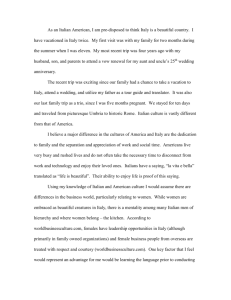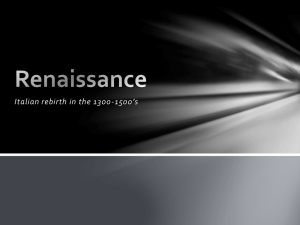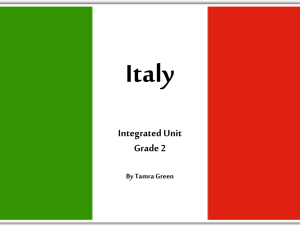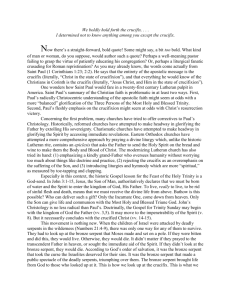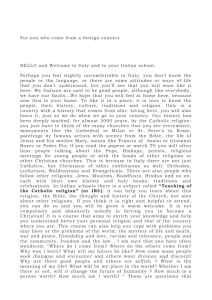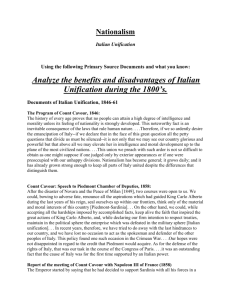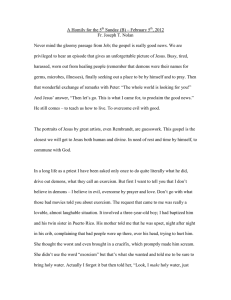The European Court Leads the Way to a Europe of... The European Court of Human Rights in Strasbourg ruled last... mandated display of the crucifix in classrooms amounts to a...
advertisement
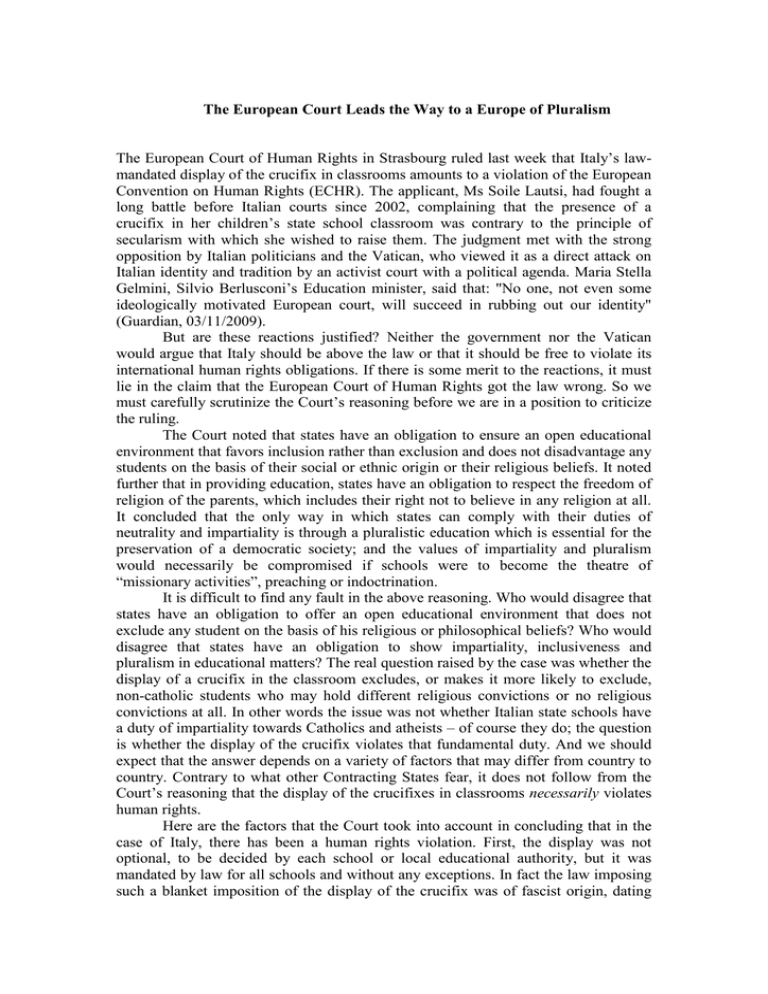
The European Court Leads the Way to a Europe of Pluralism The European Court of Human Rights in Strasbourg ruled last week that Italy’s lawmandated display of the crucifix in classrooms amounts to a violation of the European Convention on Human Rights (ECHR). The applicant, Ms Soile Lautsi, had fought a long battle before Italian courts since 2002, complaining that the presence of a crucifix in her children’s state school classroom was contrary to the principle of secularism with which she wished to raise them. The judgment met with the strong opposition by Italian politicians and the Vatican, who viewed it as a direct attack on Italian identity and tradition by an activist court with a political agenda. Maria Stella Gelmini, Silvio Berlusconi’s Education minister, said that: "No one, not even some ideologically motivated European court, will succeed in rubbing out our identity" (Guardian, 03/11/2009). But are these reactions justified? Neither the government nor the Vatican would argue that Italy should be above the law or that it should be free to violate its international human rights obligations. If there is some merit to the reactions, it must lie in the claim that the European Court of Human Rights got the law wrong. So we must carefully scrutinize the Court’s reasoning before we are in a position to criticize the ruling. The Court noted that states have an obligation to ensure an open educational environment that favors inclusion rather than exclusion and does not disadvantage any students on the basis of their social or ethnic origin or their religious beliefs. It noted further that in providing education, states have an obligation to respect the freedom of religion of the parents, which includes their right not to believe in any religion at all. It concluded that the only way in which states can comply with their duties of neutrality and impartiality is through a pluralistic education which is essential for the preservation of a democratic society; and the values of impartiality and pluralism would necessarily be compromised if schools were to become the theatre of “missionary activities”, preaching or indoctrination. It is difficult to find any fault in the above reasoning. Who would disagree that states have an obligation to offer an open educational environment that does not exclude any student on the basis of his religious or philosophical beliefs? Who would disagree that states have an obligation to show impartiality, inclusiveness and pluralism in educational matters? The real question raised by the case was whether the display of a crucifix in the classroom excludes, or makes it more likely to exclude, non-catholic students who may hold different religious convictions or no religious convictions at all. In other words the issue was not whether Italian state schools have a duty of impartiality towards Catholics and atheists – of course they do; the question is whether the display of the crucifix violates that fundamental duty. And we should expect that the answer depends on a variety of factors that may differ from country to country. Contrary to what other Contracting States fear, it does not follow from the Court’s reasoning that the display of the crucifixes in classrooms necessarily violates human rights. Here are the factors that the Court took into account in concluding that in the case of Italy, there has been a human rights violation. First, the display was not optional, to be decided by each school or local educational authority, but it was mandated by law for all schools and without any exceptions. In fact the law imposing such a blanket imposition of the display of the crucifix was of fascist origin, dating back to 1924. Second, Italy is a country where the vast majority of the population is Catholic Christian, which inevitably increases the pressure felt on those who do not adhere to the dominant religion. Third, the Court found that, contrary to the submissions of the Italian government, the perception of the crucifix in Italy is predominantly that of a religious symbol and less so that of a historical or secular symbol. Fourth, the display of the crucifix in the classroom places an excessive burden on non-Catholics students, as they have no option to avoid being exposed to it. Fifth, the display of the crucifix was part of the public function of the Italian state in an area (primary and secondary school education) that it controls and that affects directly young children. It was all these factors in combination that led the European Court to conclude that, in the circumstances of this case, Italy was in breach of the ECHR. Again, it is difficult to find any fault in the above reasoning: we do know that that the stronger the majority’s religion is and the more it is supported by the state, the more likely it is that it will lead to the exclusion of minorities. We also know that there is a strong presumption against blanket measures, such as disenfranchising all prisoners regardless of the severity of the offence, or collecting DNA evidence from all suspects regardless of whether there has been a criminal conviction. Blanket measures are disproportionate, unfairly disadvantaging some of those to whom they apply. The duty to display the crucifix in a classroom regardless of the composition of the class and without assessing the likelihood of exclusion is a disproportionate measure. Finally, we also know that in the majority of European states it is neither possible nor desirable to rid the majority’s religion off the public space so that the state becomes ‘religion-blind’. The presence of an official church, religious public holidays, and other religious practices such as the singing of hymns is an unavoidable reality. The aim is not to create a ‘religion-blind’ state but to ensure that in the allocation of fundamental rights, opportunities and benefits such as education, people who do not adhere in the dominant religion are not put at a significant disadvantage. It is precisely because the state controlled exclusively the distribution of educational opportunities in this case that the issue of impartiality and neutrality towards nonCatholics became pertinent. Those who condemned the judgment were therefore wrong to see it as an attack on Italian identity and culture, let alone an attack on Christianity. The crucifix may still thrive as a cultural and traditional symbol in areas where there is no danger of disadvantaging non-Catholics in the distribution of fundamental rights and opportunities. Moreover, by removing some of the factors that contributed to the finding of a violation (such as the law-mandated requirement to display the crucifix, or the absence of a right to opt-out), Italy may still be able to allow state schools to display the crucifix. Whether or not the display violates human rights is a complex context-specific judgment that must be made carefully for each different country. As it is often the case, rulings of the European Court of Human Rights are misunderstood and distorted by those who are inclined to see them as an external attack on national identity. The judgment is not yet final as it may be overruled by the Grand Chamber of the European Court and Italy has already indicated that it will ask for the case to be referred. The Chamber of the European Court gave a well-reasoned judgment that was based on principles of pluralism and impartiality that all people living in Europe have a reason to accept. It followed human rights principles that all contracting states in Europe accept and it applied, rather than, ignored the law. In the past, Strasbourg has been reluctant to give effect to such principles in the field of religion, granting states a margin of appreciation, for fear of upsetting them. It is now time for the Grand Chamber of the European Court of Human Rights to reaffirm strongly its doctrine that “such are the demands pluralism, tolerance and broadmindedness without which there is no 'democratic society’”.
